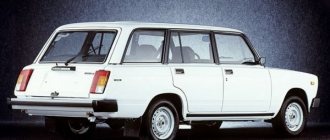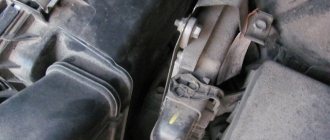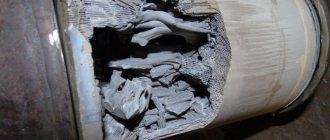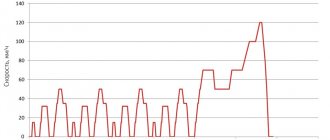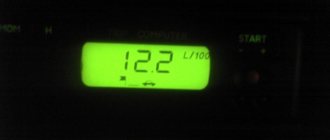This is the very first model that was produced at the Volzhsky Automobile Plant. It was the VAZ 2101 that laid the foundation for a family of incredibly popular classic Soviet cars, which were in great demand both in our country and abroad.
The first copy appeared in 1970, and production of the basic version ended in 1988. Then various modifications were produced on the same platform. The model also received the award as “Best Domestic Car of the 20th Century.”
Model review: VAZ 2104 without embellishment
Few people know that the VAZ 2104 (“four”) also bears the foreign name Lada Nova Break. This is a five-seater station wagon, which belongs to the second generation of AvtoVAZ “classics”.
The first models left the factory in September 1984 and thereby replaced the first generation station wagon - VAZ 2102. Although for another year (until 1985) the Volzhsky Automobile Plant produced both models simultaneously.
"Four" - the first station wagon in the VAZ line
VAZ 2104 cars were created on the basis of the VAZ 2105, only they had significant differences:
- extended rear part;
- folding rear bench;
- increased gas tank up to 45 liters;
- rear wipers with washer.
Export model for the Spanish car market
Along with the VAZ 2104, its modification was also produced - the VAZ 21043. This is a more powerful car with a 1.5 liter carburetor engine and a five-speed gearbox.
VAZ 2101 fuel consumption
Home » Fuel consumption » VAZ 2101 fuel consumption
Real reviews from owners about fuel consumption on the VAZ 2101:
I have a VAZ 2101 car from the very beginning. Now I rarely ride it, since I’m retired and mostly my grandchildren come to visit me. What can I say about the car, but that for its age it was a reliable type of vehicle. A 1.2 liter car consumed 12 liters in the city and 8 liters on the highway. On the highway, consumption increases by a liter for every additional 10 km/h. The optimal driving speed is 90 km/h. on AI92 you can get 7 liters per hundred square meters. Speed is limited by a four-speed gearbox.
Alexey Saratov:
The owner of a VAZ 2101 equipped with a 1.2 liter engine. I’m probably the last owner, since it will be difficult for me to sell this metal. First of all, there is little left of the body, but the engine runs smoothly after a major overhaul. The car's consumption at the best of times was 13 liters city and 9 liters highway. It is better to keep the speed at 90 km/h, since going faster is not only expensive, but also dangerous, since an unexpected breakdown is possible.
Vasily Sinye Lipyagi:
VAZ 2101 car, manufactured in 1979. Under the hood is a 1.3 liter engine. The car body has been processed since I got the export version. I can tell you a lot about the car, starting with the chassis and ending with the engine.
During the entire period of operation, I had to change all the spare parts, and please pay attention to the fact that the old worn parts were manufactured with high quality, not like now they are just consumer goods. Fuel consumption today is multifaceted, since the car is far from new and my grandchildren mostly drive it when they come to visit me
I live in a village and the drive to the city is about 120 kilometers. For a journey of 250 km I have to fill 25 liters. That is, 100 km. The route takes 10 liters of AI92 fuel. I travel around the city for a long time, mainly to the market, to a couple of shops and back. Therefore, it is difficult to say exactly how much fuel a car consumes in city mode, but I can assume that it is no less than 15 liters per hundred square meters, since in the village this is approximately what I get. Naturally, traffic jams, traffic lights, etc. as in the city there is no.
Sergey Kursk:
I recently purchased a VAZ 2101 with a 1.3 liter engine. The year of manufacture is 1988, and it is equipped with a four-speed transmission. Ask me why I need this rarity, but that’s exactly why I bought it. I want to restore and slightly modernize the body. Now the engine is running smoothly but the chassis needs to be rebuilt. I have already covered 300 km and spent about 30 liters of gasoline on everything. I had to travel both in the city and outside the city. For its year, the car showed good fuel consumption
Yes, I will say that a very important detail of this car is that I am only the second owner and the first one loved my car very much. What can I say about the VAZ 2101, but that I don’t recommend connecting your life with this car, because it’s literally “hemorrhoids”. It breaks down by leaps and bounds
Whatever you touch, everything inevitably falls off or does not turn away. But this is half the trouble, but the most unpleasant thing is the consumption, which is simply phenomenal. On the highway, the maximum it can reach is 110 km/h, and it seems that the engine will tear itself apart in a few minutes. At this speed the car consumes 15 liters per hundred
In the city it works out to be about the same if you don’t take into account traffic lights and several hours of standing in traffic jams. In traffic jams, I immediately turn off the car and try to push it, if possible, since the starter has flown more than once
Interesting Facts
The last VAZ-2101 was released in 1982; after 1977, the manufacturer stopped modernizing the car, but despite this, domestic vehicles still travel around the country and change hands from one owner to another. In 2000, a survey was conducted among car enthusiasts on the topic “The best Russian car of the century.” 80,000 respondents gave this title to the VAZ-2101, the Volga scored 19%, and the Lada of the tenth model took third place.
Over the entire history of the VAZ-2101, the plant produced 2,700,000 “kopecks”, using which the owners, together with the designers, were able to jointly make a revolution in the paint and varnish and rubber industrial sectors of the Russian autodrome. In total, 800 changes were made; thanks to multiple modernizations, the VAZ-2101 began to be loved not only by Russians, but was also exported to neighboring countries.
How to find out your gasoline consumption level
First of all, in order to understand the scale of the existing problem, you need to measure the existing fuel consumption values. To do this, you need to stop by a gas station and fill a full tank of gasoline, which holds 39 liters. At the same time, the current mileage traveled by the vehicle must be measured and recorded. After approximately half of the fuel has been consumed, the tank is refilled to capacity. The mileage readings on the odometer are recorded again.
Now we have the initial data necessary to calculate what fuel consumption is inherent in our VAZ 2107. If this value is significantly higher than what should be according to the service book, it means that there are faults in the injection system, or the carburetor requires more precise settings.
Method number 2. "Full tank and gas station"
This method differs from the previous method only in its simplicity. In terms of accuracy, it is the same - not very, so to speak.
Algorithm:
- We fill up the gas station with a full tank.
- We reset the daily mileage.
- We drive in the same way as stated above - about 100 km in your usual mode.
- We stop at the nearest gas station and fill the tank full again.
- We write down how much we refueled this time (V), and how far we drove from the previous refueling (S).
- We substitute the resulting numbers into the same formula and get the mileage in liters per hundred.
This method is simpler in that you don’t need a canister, and you don’t have to fill the gas tank from it (you also need a funnel for this). But its accuracy is similar to the first method.
VAZ-2105
It is quite difficult to imagine a car enthusiast who is unfamiliar with the legendary VAZ-2105 model. Production of the latter began in the 80s. last century.
The first models were equipped with carburetor engines of different sizes and power:
- The 1.2 liter carburetor had a power of 59 hp. With;
- the 1.3 liter carburetor had a power of 69 hp. With.;
- 1.5 liter carburetor engines provided a power of 71 hp. With.
After 10 years, the manufacturer equipped the VAZ-2105 with a more powerful engine, with central fuel injection, which could reach speeds of up to 71 hp. s., its engine capacity was 1.5 liters.
The fuel consumption of a car of this brand depends on several factors:
- depending on the time of year;
- from the place of operation of the car, that is, the car is used in the city or outside its boundaries;
- on the number of traffic jams.
The average consumption in the city is 10 l/100 km, on the highway 7 l/100 km; if car owners have to stand in traffic jams for a long time while driving, especially in winter, then the consumption can increase to 15 l/100 km.
VAZ 2108
Production of a small-sized V8 with three doors began in Togliatti in 1984. Until 2005, when the model was discontinued, it did not see a single generation change, but was extremely popular throughout the Soviet and post-Soviet space. The 2108 was equipped with one of three types of gasoline engines. In a car with a 1.1-liter engine with 54 hp. The fuel supply was provided by a carburetor. On cars with an engine capacity of 1.3 liters and a carburetor, the power was 64 “horses”, and with an injector the power increased to 140 hp. 1.5-liter engines could produce either 70 or 78 “horses”.
| Engine | Consumption (city) | Consumption (highway) | Flow (mixed) | Type of fuel |
| 1.1 MT 54 hp | 8.2 | 5.2 | 6.8 | Petrol |
| 1.3 MT 64 hp | 8.6 | 5.4 | 7.0 | |
| 1.3 MT 140 hp | 9.5 | 7.8 | 8.2 | |
| 1.5 MT 70 hp | 8.6 | 5.7 | 7.8 | |
| 1.5 MT 78 hp | 8.0 | 5.4 | 6.7 |
Specifications
A car in a station wagon weighs a little, only 1020 kg (for comparison: the “five” and “six” in a sedan body weigh more - from 1025 kg). The dimensions of the VAZ 2104, regardless of the configuration, are always the same:
- length - 4115 mm;
- width - 1620 mm;
- height - 1443 mm.
The base of the “five” was significantly improved and modified.
Thanks to the folding rear row, the trunk volume can be increased from 375 to 1340 liters, which made it possible to use the car for private transportation, country work and even small businesses. However, the back of the rear sofa does not fold entirely (due to the specific design of the car), so it is impossible to transport long cargo.
Trunk capacity can be easily increased with folding rear seats
However, long elements are easy to fix on the roof of the car, since the length of the VAZ 2104 allows you to transport beams, skis, boards and other long items without the risk of creating dangerous road situations. But you cannot overload the roof of the car, since the calculated rigidity of the station wagon body is much lower than that of sedans of the next generations of VAZ.
Transportation of goods is possible not only in the trunk, but also on the roof of the car
The “Four” was equipped with two types of drives:
- FR (rear-wheel drive) is the basic equipment of the VAZ 2104. Allows you to make the car more powerful.
- FF (front-wheel drive) - selected models were equipped with front-wheel drive, as it is considered safer; subsequent versions of the VAZ began to be produced only in front-wheel drive.
Like other Lada representatives, the Four has a ground clearance of 170 mm. Even today, this is a completely reasonable ground clearance, allowing you to overcome major road obstacles.
Engine characteristics
Over the years, the VAZ 2104 was equipped with power units of different power: from 53 to 74 horsepower (1.3, 1.5, 1.6 and 1.8 liters). Two modifications (21048D and 21045D) used diesel fuel, but all other versions of the “four” consumed AI-92 gasoline.
The model was equipped exclusively with carburetor unitsDepending on the engine power, fuel consumption also varies.
Table: average fuel consumption per 100 km
| Options | Fuel consumption, l/100 km | Fuel used |
| 1.8MT 21048D | 5,5 | Diesel fuel |
| 1.5MT 21045D | 8,6 | Diesel fuel |
| 1.6MT 21041 | 8,8 | Gasoline AI-92 |
| 1.3MT 2104 | 10,0 | Gasoline AI-92 |
| 1.5MT 21043i | 10,3 | Gasoline AI-92 |
| 1.5MT 21043 | 10,3 | Gasoline AI-92 |
The VAZ 2104 accelerates to a speed of 100 km/h in 17 seconds (this is a standard indicator for all VAZs produced in the 1980–1990s). The maximum speed of the machine (according to the operating instructions) is 137 km/h.
Table: parameters of the “four” motor
| Number of cylinders: | 4 |
| Cylinder displacement, l: | 1,45 |
| Compression ratio: | 8,5 |
| Rated engine power at a crankshaft speed of 5000 rpm: | 50.0 kW.- (68.0 hp) |
| Cylinder diameter, mm: | 76 |
| Piston stroke, mm: | 80 |
| Number of valves: | 8 |
| Minimum crankshaft speed, rpm: | 820–880 |
| Maximum torque at 4100 rpm, N*m: | 112 |
| Cylinder operating order: | 1–3-4–2 |
| Octane number of gasoline: | 95 (unleaded) |
| Fuel supply system: | Electronically controlled distributed injection |
| Spark plug: | А17ДВРМ, LR15YC-1 |
Owner reviews
“I got the car from my grandfather. At first I didn’t plan to drive it, but with the advent of the crisis in our country, there was no other choice. I was lucky that before that they looked after her and took care of her as best they could. It is always clean, we only drove it on a flat road, avoiding all the potholes. I try to do everything exactly the same. As a result, I just have an ideal car, which is cheap to maintain, which is done extremely rarely, since everything is assembled here conscientiously. Yes, the equipment is poor, but the car is far from new. But it is quite enough to easily travel for work and various personal matters. I don't plan to give up the car. As for gasoline consumption, this is the only minus of the car. I usually spend up to 10 liters of fuel,” writes Vladimir from Moscow.
“I bought myself a pretty penny about 10 years ago to use it for trips to the country. Many did not advise taking it, since it is too old and has a high consumption. But all this was not important to me, since Soviet cars of that time were made to last and were indestructible, which is what I needed. I invested a lot of money to bring the car into a more or less acceptable form, but now I have a reliable and budget car. But his consumption, of course, is high. Such a small engine should not consume up to 11 liters of fuel,” wrote Dmitry from Krasnodar.
“This car has been with us since I was born. It was on it that I trained before taking my license, and it was on it that I received as a gift after I passed the exam. For several years I brought it to mind, updating the appearance, redoing the interior, replacing many parts of the suspension and chassis. But now I am the happy owner of a classic that will give odds to many foreign cars of our time. Initially, the engine was weak and ate a lot of fuel, but after modifications and firmware, it became a real beast with a moderate appetite. Now I spend no more than 8 liters,” is how Stepan from St. Petersburg speaks about his car.
“My car turned out to be the most common way for domestic cars - I received it as a gift from my father, who bought himself another one. I was very lucky that my dad treated her condition with trepidation, so she is still running, and without visible damage. Yes, some parts are worn out, but replacing them is not a problem, since they can be found at any car market for an adequate price. That's exactly what I did. Now I go and don’t worry about anything. True, it is difficult to use it in the summer, since it is quite hot here, and of course there is no air conditioning here. You have to escape with an open window. In terms of consumption, I will say that it is quite moderate and does not exceed 10 liters in the city,” Leonid from Sochi left this review.
“For a very long time this car stood idle in our garage. After I got my license and started working, I asked my father to give it to me so that I could gain experience both in driving and in repairs. The build quality and level of reliability of the Soviet car simply amazed me. After just a few minutes I was able to start a car that had been sitting idle for several years. Now I actively use it for various tasks, only sometimes resorting to minor repairs, because the car is far from new. The fuel consumption, which can reach 12 liters, is a little confusing, but otherwise the car is good,” these were the words the car received from Ruslan from Pskov.
“I bought a penny just because I wanted to sort through something and gain experience in car repairs. And so, little by little I assembled an excellent representative of the Soviet classics from an almost destroyed car. Now I drive it myself on various work errands. I usually use it in the city, since the car is rather weak for long trips on the highway. And on city roads she feels great. But it consumes a lot of fuel – about 11 liters,” writes Kirill from Ivanovo.
Fuel consumption of VAZ 2101 1.2. The size of the fuel tank of the VAZ 2101 1.2 holds 39, the mixed fuel consumption of the VAZ 2101 is 9.2. Also, fuel consumption is divided by city
Write-off of fuel and lubricants when running in a new engine
Why get confused with such a golden mechanic? I brought the act, the act was approved, why are you racking your brains? An accountant should not be aware of absolutely all issues, technologies, regulations, etc.
Maybe. But I only heard about running in engines after major overhauls. And on stands, not on cars. And I heard about running in a new car. Probably running in a new engine is similar to running in a car. By the way, during break-in, an increasing consumption coefficient of 10% is applied. But then I can’t imagine how they managed to break it in without a run. But I wouldn’t even think about it. I would draw up an act for writing off diesel fuel consumed during the car repair process. And let the commission sign it. And there will be complaints from the tax authorities - but not to the accounting department. Let the mechanic take the rap, where did he put two buckets of diesel fuel?
The machine can stand still with the engine running. Well, write it in hours, but during break-in the consumption is still greater than during subsequent operation.
Source
Fuel consumption of VAZ 2103, 21033, 21035, 2106, 21061, 21063, 21065-00, 21065-01 cars
Fuel consumption measurements were carried out on rear-wheel drive VAZ 2103, 21033, 21035, 2106, 21061, 21063, 21065-00, 21065-01. At the time of measurement, the vehicle mileage did not exceed 30,000 km. All of them were in technically sound condition. Measurements along the highway were carried out on sections of roads with an average height difference, in the city with average traffic intensity. The cars were fully loaded - four people (including the driver) in the cabin and 40 kg of cargo in the trunk. The time to measure fuel consumption is mid-autumn. Gasoline – AI-92.VAZ 2103
Engine 2103, 54.1 kW/73.5 hp, volume – 1.45 l, four-speed gearbox.
Highway – 90 km/h – 7.7 l/100 km
120 km/h – 10.7 l/100 km
City – 11.9 l/100 km
VAZ 21033
Engine 21011, 2105, 48.3 kW/65.7 hp, volume – 1.3 l, four-speed gearbox.
Highway – 90 km/h – 7.6 l/100 km
120 km/h – 10.5 l/100 km
City – 10.8 l/100 km
VAZ 21035
Engine 2101, 48.3 kW/65.7 hp, volume – 1.2 l, four-speed gearbox.
Highway – 90 km/h – 7.6 l/100 km
120 km/h – 10.0 l/100 km
City – 10.8 l/100 km
VAZ 2106
Engine 2106, 56.3 kW/76.4 hp, volume – 1.57 l, four-speed gearbox.
Highway – 90 km/h – 7.4 l/100 km
120 km/h – 10.1 l/100 km
City – 10.3 l/100 km
Table of fuel costs for VAZ brands.
The table describes the average costs for different VAZ brands . Fuel consumption is presented in three types - city, highway and mixed (average) fuel consumption. All data on fuel costs are from the VAZ car manufacturer. For almost all brands of VAZ cars, fuel consumption does not exceed 10 liters per 100 km, with the exception of the carburetor Niva.
Average fuel consumption VAZ
liter/100 km
120 km/h=10
120 km/h=9.8
| Brand VAZ | Power, hp | City | Route | |
| VAZ 2101 (1.2, carburetor) | – | 10.5 | 11 | |
| VAZ 2102, 2103 (1.5, Carburetor) | 71 | 11 | 11.5 | |
| 2106 (1.57 engine, carburetor, four-speed gearbox) | 76.4 | 9.5 | 10.5 | 8.5 |
| 2106 (1.45 engine, carburetor, four-speed gearbox) | 73.5 | 9.9 | 10.8 | 9.0 |
| 2106 (engine 1.6, injector) | – | 8.4 | 9.8 | 7 |
| 2105 (1.3, carburetor) | 64 | 9.1 | 10.2 | 8.1 |
| 2105 (1.5, carburetor, four-speed gearbox) | 71.1 | 8.8 | 9.5 | 8.0 |
| 2107 (1.6, injector) | – | 7.8-9.8 | 9-11.5 | 6.7-8.2 |
| 2107 (1.6, carburetor) | – | 8.9 | 10.2 | 7.5 |
| 2107 (1.5, carburetor) | – | 8.3 | 9.6 | 7.0 |
| 2108, 2109, 21099 (1.5, carburetor) | 72 | 9.1 | 10.1 | 8.2 |
| 21083, 21093, (1.5, injector) | 72 | 7.6 | 8.5 | 6.7 |
| 2110, 2111, 2112 (1.5, carburetor) | 67.7 | 9.5 | 10.5 | 8.4 |
| 2110, 2111, 21124 (1.5, injector) | 72 | 7.9 | 8.7 | 7.0 |
| 2113, 2114, 2115 (1.5, injector) | 72 | 7.6 | 8.5 | 6.7 |
| Lada Granta (8 valve) | 80 | 7.0 | 8.3 | 5.8 |
| Lada Granta (8 valve) | 90 | 7.7 | 9.3 | 6.1 |
| Lada Granta (16 valve) | 98, 106, 120 | 8.1-10.1 | 9.2-11.2 | 7-9 |
| Lada Kalina 21117, 21118, 21119 (1.4 engine) | – | 6.9 | 7.8 | 6.0 |
| Lada Kalina 21118, 21119 (engine 1.6) | – | 7.2 | 8.1 | 6.3 |
| Lada Priora (1.6) | 90 | 7.6 | 8.8 | 6.5 |
| Lada Priora (1.6, 16 valve) | 106 | 8.6 | 9.5 | 7.7 |
| Lada Vesta 21179 (1.8, 16 valve) | 123 | 8.5-10.5 | 9.5-11.5 | 7.5-9.5 |
| Lada Vesta 21129 (1.6, 16 valve) | 106 | 8-10 | 9.0-11.0 | 7.0-9.0 |
| Lada x-Ray (X-ray, 1.6, 16 valves) | 110 | 7.9 | 8.8 | 7.0 |
| Lada x-Ray (X-ray, 1.8, 16 valves) | 122 | 8.1 | 9.1 | 7.2 |
| Lada Largus (1.6, 8 valve) | 90 | 8.6 | 9.5 | 7.7 |
| Lada Largus (1.6, 16 valve) | 105 | 8.2 | 9.0 | 7.5 |
| VAZ 21213 (Niva, 1.7, carburetor) | – | 11.5 | 13.0 | 10.0 |
| VAZ 21214 (Niva, 1.7, injector) | – | 9.8 | 11.0 | 8.5 |
| VAZ 2131 (Niva, 1.8, injector) | – | 11.1 | 12.8 | 9.5 |
VAZ has acceptable fuel consumption!
The car is given good dynamics and acceptable fuel consumption thanks to its reliable engine. VAZ has an affordable price for both a new and an old car. Old VAZ brands are acceptable to most people. The new VAZ engine demonstrates extreme efficiency, thanks to which the car has low fuel consumption and a reduced level of harmful emissions into the atmosphere.
VAZ - average quality cars, affordable price and acceptable fuel consumption.
What could cause increased consumption at VAZ?
1. Increased VAZ fuel consumption is observed in cars with a worn out engine. High piston wear will increase fuel consumption of any VAZ brand. Wear is determined by measuring compression in the VAZ engine block. If the compression is low, the piston needs to be replaced (rings, piston, block boring).
2. The increased flow rate is influenced by the coolant temperature, throttle position, mass air flow and detonation sensors.
3. High fuel consumption in VAZ cars is observed when the accelerator drive is faulty, the wheel alignment is adjusted correctly, or tire pressure is reduced.
4. An increase in fuel consumption in VAZ cars with carburetor engines is observed when there is a problem with the carburetor. These are holes in the diaphragms, incorrect adjustment of the choke cable, enlarged fuel jets, mixing up of air jets in two working chambers (chamber 1 = 165 mm, chamber 2 = 125 mm).
Timely completion of technical inspection will allow VAZ to maintain fuel consumption at the level declared by the manufacturer.
Place in the lineup
In the silhouette of the popular station wagon VAZ 2104, the contours of its prototypes are easily read - the domestic VAZ 2102 and the Italian Fiat 124 Familiare. These contours are modest and laconic, but stylish and modern. It’s not for nothing that the “four” have become so tightly integrated into the market. From 1984 to 2012, it rolled off the production lines of seven companies, including AvtoVAZ and IzhAvto. The “four” ousted its domestic predecessor from production within a year, and outlived the Italian by two decades.
Having decided to update the model of the first generation rear-wheel drive station wagon, AvtoVAZ designers did not look for good from good. The body of the popular VAZ 2105 sedan was made two-volume, supplemented with parts from the VAZ 2102. The result was model 2104. The model looked fresh and retained all the functional advantages of its predecessors, such as a low loading height and the absence of a rear side in the luggage compartment.
The only objection that the market expressed concerned the engine power. Driving with a large cargo compartment filled to capacity required a more powerful power unit. “Fours” were often used for cargo and passenger transportation, including off-road, and the issue of engine power was very relevant.
The answer to this market challenge was the VAZ 21043 model. This time, the designers were also not particularly clever. The station wagon was equipped with a more powerful engine, which has proven itself in terms of the ability to repair it, with a VAZ 2103 carburetor engine with a displacement of 1.5 liters.
The car turned out to be a sight to behold. Optimal in terms of “functionality/comfort” ratio, it made it possible to take the wife to the general store and feed to the farm. Balanced in terms of power/efficiency ratio, the car confidently accelerated and maneuvered with a full load.
Technical characteristics of VAZ 2104
| Engine | 1.3l | 1.2l | 1.5l | 1.7l | 1.5l | |
| Length, mm | 4115 | 4115 | 4115 | 4115 | 4115 | 4115 |
| Width, mm | 1620 | 1620 | 1620 | 1620 | 1620 | 1620 |
| Height, mm | 1443 | 1443 | 1443 | 1443 | 1443 | 1443 |
| Wheelbase, mm | 2424 | 2424 | 2424 | 2424 | 2420 | 2424 |
| Front track, mm | 1365 | 1365 | 1365 | 1365 | 1365 | 1365 |
| Rear track, mm | 1321 | 1321 | 1321 | 1321 | 1321 | 1321 |
| Ground clearance, mm | 170 | 175 | 170 | 170 | 170 | 170 |
| Minimum trunk volume, l | 345 | 345 | 1020 | 345 | 345 | 630 |
| Maximum trunk volume, l | 1035 | 1035 | 1475 | 1035 | 1145 | 1230 |
| Body type/number of doors | Station wagon/5 | |||||
| Engine location | Front, longitudinal | |||||
| Engine capacity, cm 3 | 1294 | 1198 | 1452 | 1690 | 1452 | 1450 |
| Cylinder type | Row | |||||
| Number of cylinders | 4 | |||||
| Piston stroke, mm | 66,8 | — | 80 | 80 | 84 | — |
| Cylinder diameter, mm | — | — | 76 | 82 | 76 | — |
| Compression ratio | 8,5 | — | 8,5 | 9,3 | 23 | 8,5 |
| Number of valves per cylinder | 2 | |||||
| Supply system | Carburetor | Carburetor | Carburetor | Mono injection | Diesel | Carburetor |
| Power, hp/rev. min. | 64/5600 | 58/5600 | 71/5600 | 79/5400 | 53/4800 | 71/5400 |
| Torque | 92/3400 | 84/3400 | 110/3400 | 127/3400 | 96/3000 | 104/3400 |
| Fuel type | AI-92 | AI-92 | AI-92 | AI-92 | Diesel | AI-92 |
| Drive unit | To the rear wheels | |||||
| Gearbox type / number of gears | Manual transmission / 4 | Manual transmission / 5 | ||||
| Gear ratio of the main pair | — | — | 4,1 | 3,9 | 4,1 | 3,91 |
| Front suspension type | Double wishbone | |||||
| Rear suspension type | One-piece bridge beam | |||||
| Steering type | Worm gear | |||||
| Turning diameter, m | 9,9 | 9,9 | 9,9 | 9,9 | 9,9 | 9,9 |
| Fuel tank volume, l | 45 | 42 | 42 | 45 | 42 | 42 |
| Maximum speed, km/h | 137 | — | 143 | 153 | 125 | 143 |
| Vehicle curb weight, kg | 1020 | 1020 | 1020 | 1050 | 1020 | 1020 |
| Permissible total weight, kg | 1475 | 1475 | 1475 | 1475 | 1475 | 1475 |
| Tires | 175/70 R13 | |||||
| Acceleration time (0-100 km/h), s | 18,5 | — | 17 | 17 | 25 | 17 |
| Fuel consumption in the urban cycle, l | 10,1 | — | 10,3 | 9,5 | — | 9,8 |
| Fuel consumption in the extra-urban cycle, l | — | — | — | — | 5,7 | — |
VAZ 2101
| Year of release | |
| Start of release of the modification | 1970 |
| Year of modification end | 1983 |
| Body | |
| Body type | Sedan |
| Number of doors | 4 |
| Passenger seats + driver | 5 |
| Body length | 4073mm |
| Body width | 1611mm |
| Body height | 1440mm |
| Vehicle wheelbase | 2424mm |
| Front track | 1349mm |
| Rear track | 1305mm |
| Ground clearance - Ground clearance | 170mm |
| Minimum trunk volume | 325l |
| Engine | |
| Engine location | Front, longitudinal |
| Engine capacity | 1198cm 3 |
| Engine power | 64 hp/5600 rpm |
| Torque | 89/3400 n*m |
| Fuel supply system | Carburetor |
| timing belt | OHC |
| Number and arrangement of cylinders | 4 (Inline) |
| Cylinder diameter | 76mm |
| Piston stroke | 66mm |
| Compression ratio | 8.5 |
| Number of valves | 8V |
| Type of fuel | AI92 |
| Transmission | |
| Drive unit | Rear |
| Number of gears | 4 |
| Gear ratio of the main pair | 4.3 |
| Suspension | |
| Front suspension type | Double wishbone |
| Rear suspension type | Helical spring |
| Brake system | |
| Front brakes | Disk |
| Rear brakes | Drums |
| Steering | |
| Steering type | Worm gear |
| Operating data | |
| Maximum speed | 140km/h |
| Acceleration time | 22 |
| Fuel consumption in the city | 9.4 |
| Fuel consumption on the highway | 6.9 |
| Fuel consumption Combined cycle | 9.2 |
| Fuel tank volume | 39 |
| Vehicle curb weight | 955kg |
| Tire size | 155 SR13 |
** Average market value
used VAZ 2101 1.2 in Ukraine
Development of the idea of station wagons at AvtoVAZ
Having launched the VAZ-2104 into production in 1984, AvtoVAZ designers did not remove the drawing paper from their drawing boards. They continued to develop the idea of a station wagon, developing variations of the flagship modification of the VAZ 21043. Over the years of production of the 43rd model, they were tested:
- 21048 - diesel VAZ-343, 1.77 liters;
- 21041i - 1.6-liter VAZ-21067 injection engine;
- 21041 VF - injection VAZ-2103 1.5 liters.
These modifications were not produced en masse, but all these years they kept domestic designers in relative shape.
Having exhausted the potential of the body in twenty years of production, and the potential of the engine in thirty years, modification 21043 left the production line. But the objective advantages of station wagons have not gone away. New groups of layout adherents have emerged. These are city dwellers with large families and young people who value the ability to transport large sports equipment.
Station wagons are strengthening their position in the market. And AvtoVAZ is the leader in this. Recently, the Lada Largus station wagon has become popular. This car, like the VAZ 2104 in its time, has a European prototype - the Dacia Logan MCV model produced by Renaul-Nissan. Lada Largus is available in both 5-seater and 7-seater versions, which expands its capabilities. Largus engines have been tested on Renault Logan and have excellent technical characteristics. The spare wheel under the bottom reduces the ground clearance, but the promising Lada Largus Cross does not have this drawback.
Domestic heirs of the legendary VAZ 21043 station wagon are still leaders in our market, now competing not only with the two-volume Moskvich-2141, but also with the KIA Ceed and Ford Focus station wagons.
How to reduce fuel consumption
There are many factors “thanks to” which a VAZ 2104 car can experience high fuel consumption, the main ones can be expressed in a list:
- Aggressive driving style, many drivers continue to accelerate even before a red traffic light, bringing the engine to roar. It is best to get rid of this habit at the learning stage, because you should not exceed the speed limit, even when you are in a hurry, this is the basic rule of the road.
- Warming up the car in the winter, unfortunately there is no escape from this, can only be saved by a heated garage.
- Refueling with low-quality fuel, you should not refuel at gas stations that look suspicious; as a rule, they are rarely responsible for the quality of gasoline.
- An injector malfunction is most often characterized by a loss of power, which subsequently leads to an increase in consumption due to an increase in the amount of gasoline injected.
These are the basic principles of efficiency of the VAZ 2104 car, although there are many more small factors for increasing consumption, because often a simple replacement of the fuel filter is enough.
Didn't find the information you are looking for? on our forum.
We recommend reading:
Fuel system VAZ 21083 injector
No spark on VAZ 09 carburetor
What kind of oil to pour into the steering gear of a VAZ 2107
Replacing the timing belt on a VAZ 2109 carburetor, reasons for belt breakage
How to tighten the belt on a VAZ 2114, manual with photo
Is it possible to fill Priora with 92 gasoline, manufacturer’s recommendations
VAZ 2107 steering pendulum on bearings - replacement
What seats are suitable for a VAZ 2114
Fuel consumption VAZ 2107
The popular domestic car VAZ 2107 (in common parlance, “seven”) is still successfully used in Russia and is not a type of car that consumes excessive gasoline. Hence the sincere love of the population for this brand. However, there are some concerns that make small car owners nervous. Namely, fuel consumption. Therefore, in this article we will look at the main fuel consumption indicators of injection and carburetor models of the VAZ 2107. We will also discuss how to reduce fuel consumption.
The situation today is such that in the foreseeable future prices for automobile fuel will not decrease. On the contrary, their constant growth is observed. In fact, there is no fixed price in the country for one or another type of gasoline, so the result is a sad picture: the price per liter of automobile fuel can change significantly upward not only at different gas stations, but also greatly depends on the location of the region. Therefore, the current pricing of gasoline is a headache for all motorists, even owners of small cars.
Fuel sensor VAZ 2107
The fuel consumption of any brand of car depends on a set of factors, starting from the most important thing - the type of engine and its condition, to the driving culture in general. But not all motorists know the nuances of safe driving, which results in real fuel savings.
KAMAZ fuel consumption
KAMAZ is a truck brand of vehicles. The volume of cargo transported depends on the carrying capacity of the machine. This indicator may vary and the larger the tonnage of cargo transported on a KAMAZ, the higher the fuel consumption will be. The fuel consumption of a car of this brand also depends on the following important points:
- machine modifications;
- driving style;
- time of year.
Old brands of this manufacturer are very popular, but they waste a lot of fuel. The maximum fuel consumption is KAMAZ 6522, for which it is up to 40 liters per hundred kilometers. New engines demonstrate good economy. Thanks to the innovative technologies introduced into the production of the engines of these machines, there is not only low fuel consumption, but also a low level of unwanted emissions into the atmosphere.
What is the fuel consumption per 100 km of VAZ-2101
When buying a domestic VAZ-2101 car, many want to understand whether the car is worth the money. Usually this brand is purchased as a workhorse, which is not afraid to load with dirty work. Fuel consumption plays an important role, especially when it comes to the carburetor system. According to reviews from owners, the mileage of rear-wheel drive cars leaves much to be desired - a maximum of 30,000 km will pass before the first breakdown, and then faults will appear one after another. By the way, fuel consumption is indicated in the passport of the purchased vehicle. But the indicated indicators do not always coincide with the realities of life. The characteristics that will be given below for the VAZ-2101 are rather considered reference; according to the manufacturer, they reflect the minimum gasoline consumption at maximum power of the car.
Place in the lineup
In the silhouette of the popular station wagon VAZ 2104, the contours of its prototypes are easily read - the domestic VAZ 2102 and the Italian Fiat 124 Familiare. These contours are modest and laconic, but stylish and modern. It’s not for nothing that the “four” have become so tightly integrated into the market. From 1984 to 2012, it rolled off the production lines of seven companies, including AvtoVAZ and IzhAvto. The “four” ousted its domestic predecessor from production within a year, and outlived the Italian by two decades.
Having decided to update the model of the first generation rear-wheel drive station wagon, AvtoVAZ designers did not look for good from good. The body of the popular VAZ 2105 sedan was made two-volume, supplemented with parts from the VAZ 2102. The result was model 2104. The model looked fresh and retained all the functional advantages of its predecessors, such as a low loading height and the absence of a rear side in the luggage compartment.
The only objection that the market expressed concerned the engine power. Driving with a large cargo compartment filled to capacity required a more powerful power unit. “Fours” were often used for cargo and passenger transportation, including off-road, and the issue of engine power was very relevant.
The answer to this market challenge was the VAZ 21043 model. This time, the designers were also not particularly clever. The station wagon was equipped with a more powerful engine, which has proven itself in terms of the ability to repair it, with a VAZ 2103 carburetor engine with a displacement of 1.5 liters.
Practical recommendations
Fuel consumption is affected by:
- technical condition of the machine;
- operating features.
In particular, an increase in the amount of gasoline or gas consumed is often a sign that the engine has almost exhausted its resource. Wear of the cylinder-piston increases the gaps between the cylinder walls and the rings. Because of this, exhaust gases and the fuel-air mixture enter the piston space. For the same reason, compression in the cylinders drops. The warm air mixture cannot burn completely. Therefore, part of the mixture remains unused and simply flies out through the exhaust pipe. Engine wear affects its functioning. Because of this, the car accelerates poorly. The driver has to press the pedal harder to accelerate the car. Taking all this into account, it is not difficult to conclude that in order to reduce gasoline or gas consumption, you must first diagnose the engine. You need to measure the compression, listen to whether the engine makes any unusual noises during operation. If worn components are found, they must be replaced.
Also, the consumption of gasoline or gas depends on the condition of the gas distribution mechanism. If carbon deposits that form on valve seats and edges are not promptly removed, this will lead to loss of compression due to a loose fit.
Cleaning the valves and, if necessary, repairing the cylinder head will significantly reduce gasoline/gas costs.
It is important to promptly diagnose the gas distribution mechanism and promptly replace worn parts
Fuel consumption also depends on the carburetor. If you install a contactless ignition system and a Solex carburetor, then this combination will reduce the amount of gasoline or gas consumed
It is very important to adjust the carburetor correctly. It will be possible to reduce consumption by installing jets with a reduced cross-section
However, this will lead to a decrease in the dynamics and power of the machine. After this adjustment you will have to forget about overtaking. It will be very difficult to accelerate such a car. Therefore, it is better to carry out adjustments without replacing the jets. It is necessary to adjust the carburetor in such a way as to achieve a “golden mean” between power and fuel consumption. If the carburetor is clogged and incorrectly adjusted, fuel dosing is disrupted. Therefore, regularly check the condition of the carburetor and wash it periodically.
New procedure for calculating the basic fuel consumption rate recommended by the Ministry of Transport
When calculating fuel costs, the following methods are used:
- Based on the formulas and data contained in the previously approved order AM-23r (published by the Ministry of Transport in March 2008 and revised several times, the latest edition was published on September 20, 2018).
- In accordance with the official gasoline or diesel fuel consumption data declared by the vehicle manufacturer. The calculation methodology used by the plant must comply with the WLTP regulations approved by the UN. The documentation stipulates the algorithm for testing vehicles intended for transporting passengers and light cargo.
Place in the lineup
In the silhouette of the popular station wagon VAZ 2104, the contours of its prototypes are easily read - the domestic VAZ 2102 and the Italian Fiat 124 Familiare. These contours are modest and laconic, but stylish and modern. It’s not for nothing that the “four” have become so tightly integrated into the market. From 1984 to 2012, it rolled off the production lines of seven companies, including AvtoVAZ and IzhAvto. The “four” ousted its domestic predecessor from production within a year, and outlived the Italian by two decades.
Having decided to update the model of the first generation rear-wheel drive station wagon, AvtoVAZ designers did not look for good from good. The body of the popular VAZ 2105 sedan was made two-volume, supplemented with parts from the VAZ 2102. The result was model 2104. The model looked fresh and retained all the functional advantages of its predecessors, such as a low loading height and the absence of a rear side in the luggage compartment.
The only objection that the market expressed concerned the engine power. Driving with a large cargo compartment filled to capacity required a more powerful power unit. “Fours” were often used for cargo and passenger transportation, including off-road, and the issue of engine power was very relevant.
The answer to this market challenge was the VAZ 21043 model. This time, the designers were also not particularly clever. The station wagon was equipped with a more powerful engine, which has proven itself in terms of the ability to repair it, with a VAZ 2103 carburetor engine with a displacement of 1.5 liters.
Place in the lineup
In the silhouette of the popular station wagon VAZ 2104, the contours of its prototypes are easily read - the domestic VAZ 2102 and the Italian Fiat 124 Familiare. These contours are modest and laconic, but stylish and modern. It’s not for nothing that the “four” have become so tightly integrated into the market. From 1984 to 2012, it rolled off the production lines of seven companies, including AvtoVAZ and IzhAvto. The “four” ousted its domestic predecessor from production within a year, and outlived the Italian by two decades.
Having decided to update the model of the first generation rear-wheel drive station wagon, AvtoVAZ designers did not look for good from good. The body of the popular VAZ 2105 sedan was made two-volume, supplemented with parts from the VAZ 2102. The result was model 2104. The model looked fresh and retained all the functional advantages of its predecessors, such as a low loading height and the absence of a rear side in the luggage compartment.
The only objection that the market expressed concerned the engine power. Driving with a large cargo compartment filled to capacity required a more powerful power unit. “Fours” were often used for cargo and passenger transportation, including off-road, and the issue of engine power was very relevant.
The answer to this market challenge was the VAZ 21043 model. This time, the designers were also not particularly clever. The station wagon was equipped with a more powerful engine, which has proven itself in terms of the ability to repair it, with a VAZ 2103 carburetor engine with a displacement of 1.5 liters.
Design features [edit | edit code]
Since the front part of the car is identical to models with a sedan body, it is more difficult for a standard heater to warm a larger volume of the interior during the cold season. The back of the car often fogs up in cold weather. The car normally does not have rear ventilation holes for venting interior air (unlike the VAZ-2107), which makes it difficult to close the doors (with the windows closed). Compared to the VAZ-2105, 2107 (with identical engine installations), it has a lower maximum speed (data from the “operating instructions”
142 km/h) due to the changed final drive ratio - 4.44 (early modifications) versus 4.3 on the sedan. The rear door is subject to contamination by road dirt (dust raised by wheels), which is locally drawn when driving at high speeds into the low-pressure zone - this is corrected by installing an upper deflector on the 5th door, supplying (to the low-pressure zone) cleaner air from the roof. There is also a way to avoid the accumulation of dirt on the back door - this is to change the design of the rear bumper - the lower part must be bent in the opposite direction and the gap between the bumper and the body must be closed - a plate 1 meter by 15 cm in the middle. The gas tank with a volume of 43 liters (versus 39) is located horizontally under the bottom of the trunk without additional protection - there is a risk of damage when driving over rough terrain.
